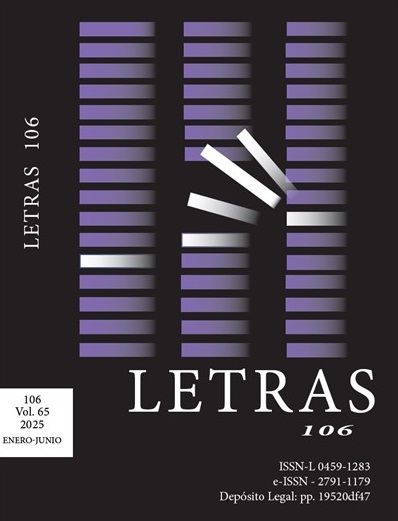From the edges: voice and paratext in the narrative construction of Jacqueline Goldberg's The clear hours (2013)
DOI:
https://doi.org/10.56219/letras.v65i106.3913Keywords:
paratext, narrative construction, The clear hours, Jacqueline GoldbergAbstract
This paper presents a close and comprehensive reading of the novel Las horas claras in order to account for its complex narrative framework. As a matter of fact, we consider that, in this work, the constant appeal to the resource of paratext (Gérard Genette) is a function of a dialogic (Mikhail Bakhtin) and intertextual (Julia Kristeva) narrative. Thus, Las horas claras becomes a sort of battlefield between voices that emerge not only from the central body of the work, but also from multiple paratexts, which, rather than accompanying or limiting it, expand its meaning and give it depth. Las horas claras, then, more than the recounting of the small history of an egregious house, should be considered the story of struggle and survival of a voice: that of Madame Savoye.
Downloads
References
Bajtín, M. M. (1993). Problemas de la poética en Dostoievski. Fondo de Cultura Económica.
Briceño Gudiño, J. (2016). Jacqueline Goldberg o los oficios tristes del abandono. Revista de Literatura Hispanoamericana, 72 40-48. https://produccioncientificaluz.org/index.php/rlh/article/view/22101
Genette, G. (2011). Umbrales. Siglo XXI Editores.
Goldberg, J. (2013). Las horas claras. Caracas: Sociedad de Amigos de la Cultura Urbana.
Gras Valero, I. (2009). “La recepción de Émile Verhaeren en el arte y en la literatura de la Cataluña de finales de siglo”. En: C. Giménez Navarro y C. Lomba Serrano (eds.). El arte del siglo XX. Actas del XII Coloquio de Arte Aragonés. IFC-Universidad de Zaragoza. [Recuperado: 16-01-24].
Hernández, A. (sf). “Las horas claras”. https://letralia.com/ciudad/hernandez/141030.htm [Recuperado: 10-09-2023].
Kristeva, J. (1981). Semiótica 1. Editorial Fundamentos.
Le Courbusier. (1998). Hacia la Arquitectura. Barcelona: Ediciones Apóstrofe. https://historiadearquitectura.wordpress.com/wp-content/uploads/2012/04/hacia_una_arquitectura_le_corbusier.pdf [Recuperado: 02-04-2024].
Lozano Marco, M. Á. (sf). “La formación de la novela lírica (1901-1910)”. https://www.cervantesvirtual.com/obra-visor/la-formacion-de-la-novela-lirica-1901-1910/html/dc4748d2-daf3-11e1-b1fb-00163ebf5e63_5.html [Recuperado: 24-08-23].
Payares, G. (2014). Jacqueline Goldberg. La casa es lo único que nos queda. Prodavinci. https://historico.prodavinci.com/blogs/jacqueline-goldberg-la-casa-es-lo-unico-que-nos-queda-por-gabriel-payares/
Perus, F. (2009). “Posibilidades e imposibilidades del dialogismo socio-cultural en la literatura hispanoamericana”. Tópicos del Seminario, 21, 181-218. https://www.topicosdelseminario.buap.mx/index.php/topsem/article/view/207/201 [Recuperado: 20-03-23]. DOI: https://doi.org/10.35494/topsem.2009.1.21.207
Saraceni, G. (2020). “Fallas en la máquina de habitar. Arquitectura, botánica, afecto en Las horas claras de Jacqueline Goldberg”. Kipus 48, 25-46. https://revistas.uasb.edu.ec/index.php/kipus/article/view/1581/1379 [Recuperado: 08-01-2023].
Published
How to Cite
Issue
Section
License
Copyright (c) 2025 LETRAS

This work is licensed under a Creative Commons Attribution-NonCommercial-ShareAlike 4.0 International License.
Letras magazine retains the patrimonial rights (copyright) of the published works, which favors and allows their reuse under the license (CC BY - NC - SA 4.0), for which they can be copied, used, disseminated, transmitted and expose publicly, as long as the authorship and original source of its publication (magazine, publisher, URL and DOI of the work) is cited, they are not used for commercial or onerous purposes and the existence and specifications of this use license are mentioned.















